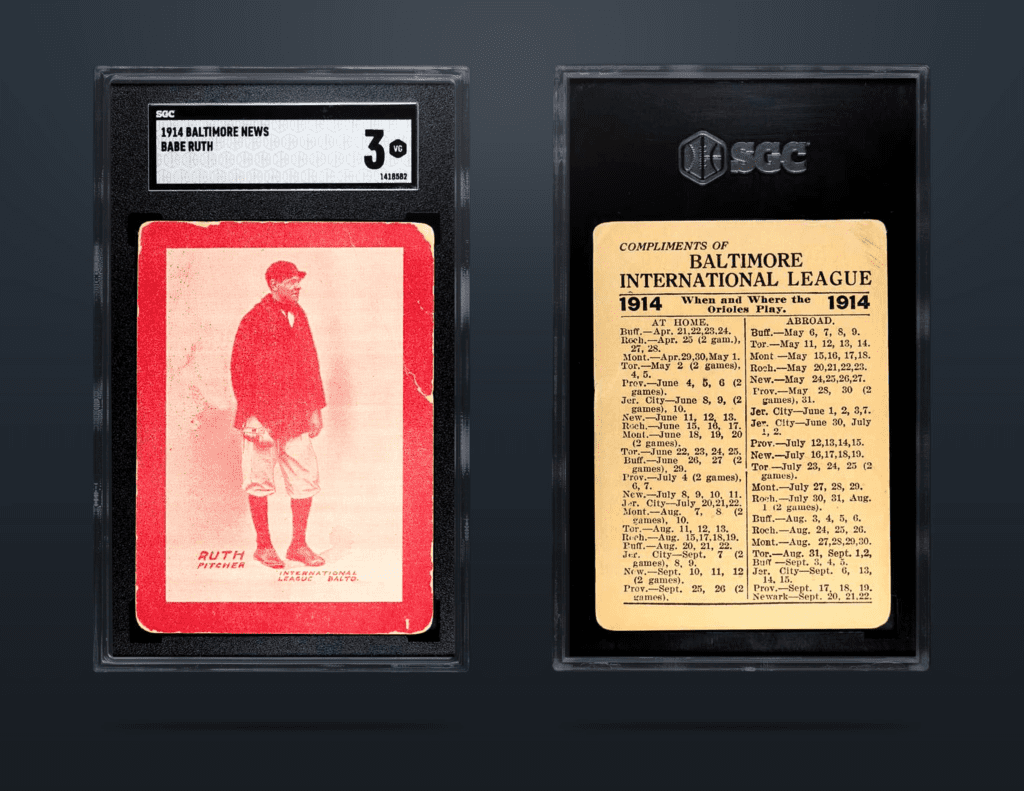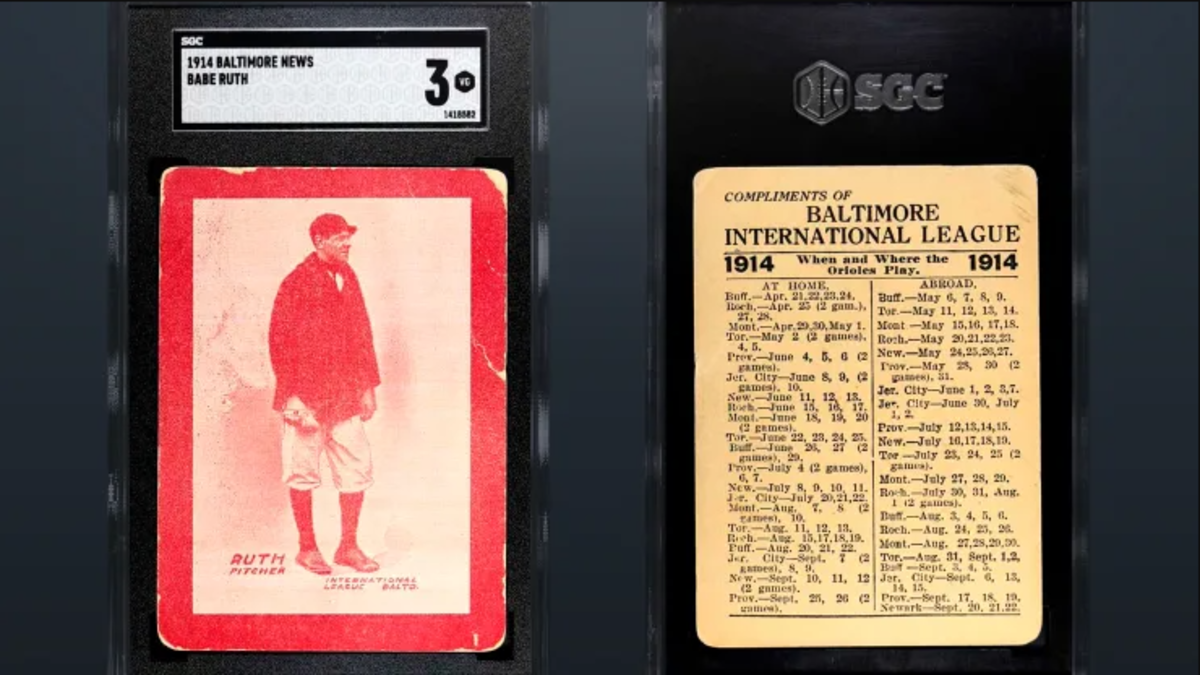Century-old Babe Ruth’s 1914 rookie card fetches $7.2M

Inna Zeyger
More Stories By Inna Zeyger
- Mother’s Day: How Anthony Volpe’s mom molded him into a Yankee phenom
- Giancarlo Stanton to rejoin Yankees for Phillies series opener on Monday
- Yankees’ top prospect Jasson Dominguez nears return after oblique injury
- Rich Hill draws Yankees’ attention for midseason signing
- ‘They don’t act like Yankees,’ Francesa criticizes team’s lack of competitiveness
- December 5, 2023
- 10:10 am
- No Comments
Table of Contents
A Babe Ruth rookie card from 1914, originally featured in the Baltimore News, recently fetched a staggering $7.2 million, inclusive of the buyer’s premium, shortly after midnight on Monday. This transaction marks the third-highest amount ever paid for a sports card, coming close to the $7.25 million record set by a T206 Sweet Caporal Honus Wagner card in August 2022.
This particular card now holds the distinction of being the priciest Babe Ruth memorabilia ever sold.
In 1914, a young paperboy named Archibald Davis, aged 16, from Baltimore, gathered baseball cards featuring his beloved Orioles, who were then part of the International (minor) League and featured in daily newspapers. Among these cards, he had a special fondness for one that portrayed a 19-year-old pitcher named Babe Ruth, born on Emory St. The card in question is the one depicting this young pitcher.
Davis’ collection comprised a total of 15 cards, and these cherished items have been passed down through multiple generations within the family. Over the span of 107 years, these cards were frequently used as playthings by children who were unaware of their significant value. In 1998, the family generously loaned the cards to the Babe Ruth Birthplace & Museum located in Baltimore. These cards remained on public display until 2021, at which point they were discreetly sold through a private transaction.
The 1914 Babe Ruth card
Brian Dwyer, president of Robert Edward Auctions, who facilitated the sale, mentioned that the Babe Ruth card had been well-preserved overall. He explained that the museum had held onto it for the last twenty-plus years, contributing significantly to its current condition. Dwyer pointed out that, to their knowledge, there are only ten similar cards known to exist.
To provide context, it’s noteworthy that PSA, a card grading service, has assessed over 1,500 1952 Topps Mickey Mantles and 32 T206 Sweet Caporal Honus Wagners for grading.
Significantly, both the Topps Mantle and the T206 Wagner have extensive mythologies, each rewriting the sports card record book in recent years with various copies. In contrast, the Baltimore News Babe Ruth, despite its remarkable rarity—being the only known copy with the same grade and one known copy graded higher—does not carry the same legendary status. However, as of the late 2000s, it held the distinction of being considered the most valuable sports card.
Brian Dwyer conveyed that Babe Ruth’s story is steeped in mythology, highlighting that he was placed under the care of St. Mary’s Industrial School at the age of 7. Dwyer explained that Babe Ruth remained a ward of the state, under the custody of the priests of St. Mary’s Industrial School, until Jack Dunn, then the owner and manager of the Orioles, noticed Ruth’s talent and assumed legal guardianship. According to Dwyer, the significance of this card lies in Babe Ruth’s experience of being a ward of the state for over two-thirds of his life, with little knowledge about the world and an uncertain future, emblematic of what the card represents.
According to Dwyer, knowledge of the Babe Ruth rookie card‘s existence didn’t truly surface until the 1980s, a surprising revelation for a figure, as Dwyer pointed out, that requires no formal introduction.
Dwyer mentioned that when they sold the record-setting Wagner for $6.6 million in 2021, they encountered individuals, even at the National Sports Collectors Convention, who approached them and inquired, “Who is Honus Wagner and why should we care?” According to Dwyer, the notable contrast is that no one questions who Babe Ruth is, understanding his significance to the game, the hobby, and American culture. Dwyer emphasized that Ruth transcends everything, expressing the belief that the Ruth card is the most significant and has yet to have its moment in the sun, so to speak.
For the first time in ten years, a Babe Ruth rookie card is being offered for sale.
Dwyer mentioned that the previous transaction for one of these Babe Ruth cards in 2013 amounted to $450,000. He pointed out that acquiring one of these cards has been comparably more challenging than purchasing an NFL team over the last decade. P.J. Kinsella, the REA communications director, further stated that it might take well over a decade, and possibly more, before another one of these cards is presented for auction.

Babe Ruth’s 1914 season
Significantly, during that particular season, Dunn made the decision to trade Ruth to the Boston Red Sox. Babe Ruth subsequently played a pivotal role, pitching the Providence Grays to the International League title that summer. By 1915, he achieved an impressive 18-8 record as a key pitcher for the major league Red Sox, being one of five pitchers on Boston’s staff to secure 15 or more wins.
Kinsella expressed amazement at the existence of the card, stating that it’s miraculous. He elaborated that Babe Ruth spent only a few months with the Orioles, and by the end of 1914, he had moved on to Providence. The fact that Babe Ruth is encapsulated in this card, not foreseeing his future prominence, is deemed remarkable by Kinsella. He highlighted the minuteness of the timeframe during which they were able to feature him in the set.
The Babe Ruth card received a grading of 3 from the card grading entity SGC (Sportscard Guaranty Corporation). It is noteworthy that the three most costly sports cards ever sold – the $12.6 million 1952 Topps Mickey Mantle card, the $7.25 million Wagner card, and now the $7.2 million 1914 Baltimore News Babe Ruth rookie card – all underwent grading by SGC.

Unique things about the card
An uncommon 1914 baseball trading card featuring the iconic American sports figure Babe Ruth during his early years, often referred to as the bambino, has been discovered. At the age of 19, Babe Ruth was a player for the Baltimore Orioles, representing his hometown when the team belonged to the International League. Notably, he went on to make his debut in Major League Baseball later in the same 1914 season, playing for the Boston Red Sox.
The baseball card from the 1914 minor league season depicts a young Babe Ruth with a youthful countenance, featuring his unmistakable broad nose. In the image, he is adorned in a dark cap and a dark sweater. As a left-handed pitcher, Babe Ruth is seen wearing a small glove on his right hand, characteristic of the equipment used during that era.
Brian Dwyer, the president of Robert Edward Auctions in New Jersey, conveyed that it is the second-highest price ever attained at auction for a trading card and the third-highest price ever paid for a trading card, as reported to FOX Business.
Initially, Babe Ruth showcased dominance as a pitcher during the early phase of his career, only to transform into the legendary Sultan of Swat slugger, a persona that continues to define his larger-than-life legacy today.
His notable sale to the New York Yankees after the 1919 season is widely recognized for initiating the “Curse of the Bambino,” a development that significantly altered the destinies of both franchises for generations to come.
Subsequently, the Yankees secured their initial four out of a historic 27 World Series titles with Babe Ruth in their lineup. Following the departure of their young star, the Red Sox experienced a notorious 86-year championship drought.
Dwyer emphasized that the card’s worth was elevated due to its rarity, being one of only 10 known to exist. Furthermore, the enduring and imposing image of Babe Ruth in American culture, nearly a century after his last baseball game, contributed significantly to its value.
What do you think? Leave your comment below.
- Categories: Babe Ruth, Babe Ruth card
- Tags: Babe Ruth, Babe Ruth card



 Follow Us
Follow Us









